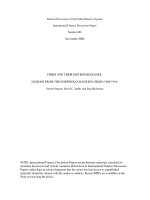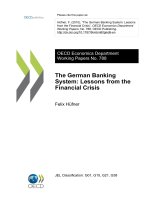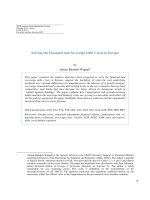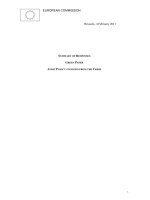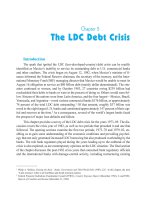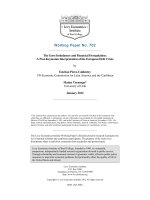heise - emerging from the euro debt crisis (2013)
Bạn đang xem bản rút gọn của tài liệu. Xem và tải ngay bản đầy đủ của tài liệu tại đây (3.84 MB, 132 trang )
Emerging from the Euro Debt Crisis
Michael Heise
Emerging from the
Euro Debt Crisis
Making the Single Currency Work
1 C
Closing Date: May 2013
ISBN 978-3-642-37526-2 ISBN 978-3-642-37527-9 (eBook)
DOI 10.1007/978-3-642-37527-9
Springer Heidelberg Dordrecht London New York
Library of Congress Control Number: 2013940081
© Springer-Verlag Berlin Heidelberg 2013
This work is subject to copyright. All rights are reserved, whether the whole or part of the material is
concerned, specically the rights of translation, reprinting, reuse of illustrations, recitation, broadcasting,
reproduction on microlm or in any other way, and storage in data banks. Duplication of this publication
or parts thereof is permitted only under the provisions of the German Copyright Law of September 9,
1965, in its current version, and permission for use must always be obtained from Springer. Violations
are liable to prosecution under the German Copyright Law.
The use of general descriptive names, registered names, trademarks, etc. in this publication does not im-
ply, even in the absence of a specic statement, that such names are exempt from the relevant protective
laws and regulations and therefore free for general use.
Printed on acid-free paper
Springer is part of Springer Science+Business Media (www.springer.com)
Michael Heise
Allianz SE
Munich, Germany
v
The crisis has changed Europe’s mindset. Since the Second World
War European integration knew only one direction, the widely ac-
cepted aim was an “ever closer union”. For sure, the process did not
always follow a straight line, but no one seriously doubted the nality
of the European project. The Greek drama and the subsequent tur-
moil on Europe’s nancial markets threw this European belief into
disarray. Suddenly, disintegration became a real and present threat; a
relapse into particularistic and nationalized European politics was no
longer unthinkable.
But it was a necessary wake-up call. After the establishment of the
monetary union and the successful enlargement to the East, Europe
became a little self-complacent. The integration process was more
and more seen as a project of the elites, the technicalities of which
were discussed by the experts in “Spaceship Brussels”. The people of
Europe did not bother to think too much about Europe and its future.
Somehow, the European project and its narrative about peace and rec-
onciliation seemed to be stuck in the 20th century. What a difference
a crisis can make.
At last, we have the necessary and intense public debate about Eu-
ropean integration and the path ahead. Even decisions by the German
constitutional court about fairly obscure paragraphs of the treaty are
suddenly top news and discussed widely by the public. And there is a
growing number of articles and books jumping on the euro bandwag-
on. This book by Michael Heise, that is based on his work as Allianz’s
chief economist, is no exception. But it differs by trying to bridge the
gulf between academic analysis and practical recommendations that
play a role for corporate decision making.
Foreword
vi
The future of the euro is essential for the political and economic
landscape on our continent for the years to come. The currency is the
touchstone of how Europe will succeed in dening its place in the
21st century. The global sea is getting rougher: the emergence of new
powers, the ageing of our societies and climate change pose formi-
dable challenges. To keep the European dream alive—which is not
only about raising prosperity but maybe even more about sustainabil-
ity, social justice and diversity—Europe as a whole has to nd new
ways of joint decision making and shared responsibilities. Otherwise,
Europe will cease to be a voice that is heard in tomorrow’s world
economic and political order. And without international relevance and
inuence, slow but steady decline seems inevitable. Of course, the
euro does not automatically bring us closer to the goal of a political
and scal union. But it has triggered intensied political efforts on
this long and probably arduous journey. But as the saying goes, every
journey starts with a single step, and that has been undertaken.
Michael Diekmann
Foreword
vii
The ideas and conclusions in this publication are based on many years
of ongoing research at the Economic Research and Corporate Devel-
opment department of Allianz SE in Munich, Frankfurt and London.
Many colleagues have given their input to this work. First of all I
would like to thank Anna Sophia Winter and Laura Pütz who worked
as interns in my department over the past few months and assisted me
very ably in the necessary research and the development of charts and
tables. Teresa Schill and Maximilian Müller deserve a special men-
tion as they helped to draft some paragraphs of the text and assisted
in the co-ordination of the project along with my personal assistant
Bianca Mittermeier. I have also beneted greatly from discussions
with my colleagues at Allianz Economic Research. I thank all of them
and would like to highlight the support provided by Ann-Katrin Pe-
tersen, Dr. Arne Holzhausen and Dr. Rolf Schneider as well as the
excellent editing by Alexander John Maisner. A special thanks goes
to Prof. Dr. Paul J. J. Welfens, Wuppertal for valuable comments and
suggestions. Any mistakes are my own responsibility.
Various aspects of the topic have also been dealt with in a series
of lectures and seminars that I have held at Johann-Wolfgang Goethe
University Frankfurt in cooperation with Prof. Dr. Beatrice Weder di
Mauro, Mainz, and Prof. Dr. Rainer Klump, Frankfurt since the crisis
took shape in 2007/2008. The book explores some of the technical
and theoretical issues in a hopefully easy manner and it addresses
readers who are interested not only in the policy conclusions but also
in the basic economics at work. This is essential in order to bring
some clarity to the mass of conicting arguments put forward in the
public discussion. While in some chapters the book does quote quite
a few recent publications on the relevant issues, it does not offer a
comprehensive overview of the extensive literature that has been pub-
Preface
viii
lished on the economics of European integration and the recent debt
crisis. The book is written from the point of view of a business econo-
mist who assists corporate decision making and not from a primarily
academic perspective.
Preface
ix
Contents
1 Introduction:ManagingComplexity. . . . . . . . . . . . . . . . . . 1
2 ThePathtoEuropeanMonetaryUnion . . . . . . . . . . . . . . . 5
References . . . . . . . . . . . . . . . . . . . . . . . . . . . . . . . . . . . . . . . . 16
3 TheEvolutionoftheDebtCrisis . . . . . . . . . . . . . . . . . . . . . 17
References . . . . . . . . . . . . . . . . . . . . . . . . . . . . . . . . . . . . . . . . 22
4 EconomicImpactoftheEuro—WhoBenefits? . . . . . . . . . 23
4.1 A Global Currency Emerges. . . . . . . . . . . . . . . . . . . . . . 24
4.2 Low Ination in the Eurozone . . . . . . . . . . . . . . . . . . . . 26
4.3 Impact on Growth Inconclusive . . . . . . . . . . . . . . . . . . . 27
4.4 Intensication of Intra-EMU Trade and Capital Flows . 30
4.5 Advantages for German Exports in Times of Reform . . 32
References . . . . . . . . . . . . . . . . . . . . . . . . . . . . . . . . . . . . . . . . 34
5 Re-assessingtheCriteriaforanOptimum
CurrencyAreainEurope . . . . . . . . . . . . . . . . . . . . . . . . . . . 35
5.1 Asymmetric Shocks and Adjustment Options . . . . . . . . 36
5.2 Openness of the Economy and Diversity
of its Trade Sector. . . . . . . . . . . . . . . . . . . . . . . . . . . . . . 37
5.3 Wage Flexibility and Labour Mobility . . . . . . . . . . . . . . 40
5.4 Capital Mobility . . . . . . . . . . . . . . . . . . . . . . . . . . . . . . . 43
5.5 Financial Market Integration . . . . . . . . . . . . . . . . . . . . . 45
5.6 Coherence in the Perception of Economic Policy . . . . . 48
References . . . . . . . . . . . . . . . . . . . . . . . . . . . . . . . . . . . . . . . . 49
6 WhatWentWrongwithPublicDebtand
MacroeconomicStabilization? . . . . . . . . . . . . . . . . . . . . . . . 51
6.1 A Toothless Stability Pact . . . . . . . . . . . . . . . . . . . . . . . . 52
6.2 The Danger of Macroeconomic Imbalances. . . . . . . . . . 57
References . . . . . . . . . . . . . . . . . . . . . . . . . . . . . . . . . . . . . . . . 65
x Contents
7 PolicyConclusions . . . . . . . . . . . . . . . . . . . . . . . . . . . . . . . . . 67
7.1 Escaping the Debt Trap—Balancing Austerity
and Growth . . . . . . . . . . . . . . . . . . . . . . . . . . . . . . . . . . . 68
7.1.1 Balancing Consolidation and Growth-
Oriented Reform. . . . . . . . . . . . . . . . . . . . . . . . . 68
7.1.2 Many Countries Have Successfully Done It:
Consolidation Plus Reform. . . . . . . . . . . . . . . . . 71
7.1.3 Debt Scenarios for The Future . . . . . . . . . . . . . . 76
7.1.4 Base Scenario: “Spending Discipline, Slow
Reduction in Risk Premiums, Moderate
Economic Growth”. . . . . . . . . . . . . . . . . . . . . . . 79
7.1.5 Risk Scenario: “Insufcient Consolidation
Efforts, Weaker Economic Growth”. . . . . . . . . . 80
7.1.6 Positive Scenario: “Spending Discipline,
Stronger Economic Growth” . . . . . . . . . . . . . . . 80
7.1.7 The Scenario Analysis Shows: Reversing The
Debt Momentum is Not an
Insurmountable Task. . . . . . . . . . . . . . . . . . . . . . 81
7.2 Counteracting Macroeconomic Imbalances . . . . . . . . . . 81
7.3 The Euro 2023: A Narrative . . . . . . . . . . . . . . . . . . . . . . 85
7.3.1 Institutional Changes and Different Speeds
of Integration . . . . . . . . . . . . . . . . . . . . . . . . . . . 88
7.3.2 Fiscal Guidance: Controls With Teeth . . . . . . . . 91
7.3.3 Macroeconomic Surveillance, Banking
Supervision and Structural Reform Incentives. . 93
References . . . . . . . . . . . . . . . . . . . . . . . . . . . . . . . . . . . . . . . . 95
8 AligningCrisisManagementandLong-Term
ReformIncentives . . . . . . . . . . . . . . . . . . . . . . . . . . . . . . . . . 97
8.1 A Framework Conducive for
Long-Term Investments . . . . . . . . . . . . . . . . . . . . . . . . . 98
8.2 The Mutualisation of Debt In the Eurozone . . . . . . . . . . 102
8.3 The Learning Curve In Crisis Management . . . . . . . . . . 106
8.4 Devising the Right Instruments—A Brief
Comparison of Alternative Solutions . . . . . . . . . . . . . . . 108
8.5 Why Not Transform the Eurozone? . . . . . . . . . . . . . . . . 112
References . . . . . . . . . . . . . . . . . . . . . . . . . . . . . . . . . . . . . . . . 115
9 AFinalWord . . . . . . . . . . . . . . . . . . . . . . . . . . . . . . . . . . . . . 117
References . . . . . . . . . . . . . . . . . . . . . . . . . . . . . . . . . . . . . . . . 119
Index . . . . . . . . . . . . . . . . . . . . . . . . . . . . . . . . . . . . . . . . . . . . . . 121
xi
AQTIV Aktivieren, Qualifizieren, Trainieren, Investieren,
Vermitteln
BIS Bank for International Settlements
bn billion
BNP Banque Nationale de Paris
ca. circa
CAP corrective action plan
Co. Compagnie
COM Commission
cp consumer price
DVA Deutsche Verlags-Anstalt
e.g. exempli gratia
EC European Commission
ECB European Central Bank
ECSC European Coal and Steel Community
ECU European Currency Unit
eds. editors
EEC European Economic Community
EFSF European Financial Stability Facility
EFSM European Financial Stabilisation Mechanism
EIP Excessive Imbalance Procedure
EMCF European Monetary Cooperation Fund
EMI European Monetary Institute
EMS European Monetary System
Abbreviations
xii
EMU European Monetary Union
ERCD Economic Research and Corporate Development
ERM exchange-rate mechanism
ESCB European System of Central Banks
ESM European Stability Mechanism
ESRB European Systemic Risk Board
et al. et alia
ETUC European Trade Union Conferderation
EU European Union
EUR euro
Euratom European Atomic Energy Community
FDI foreign direct investment
G7 Group of Seven
GDP gross domestic product
GLF Greek Loan Facility
GmbH Gesellschaft mit beschränkter Haftung
HCPI Harmonised Consumer Price Index
i.e. id est
IIF Institute for International Finance
IMF International Monetary Fund
KG Kommanditgesellschaft
lhs left-hand scale
LTRO longer-term refinancing operations
MFIs Monetary Financial Institutions
MPC Monetary Policy Committee
no. number
NJ New Jersey
OECD Organisation for Economic Co-operation and Development
OMT Outright Monetary Transactions
Abbreviations
xiii
P page
p.a. per anno
ppts. percentage points
PSI private sector involvement
Q quarter
rhs right-hand scale
SE Societas Europaea
SGP Stability and Growth Pact
SMP Securities Market Programme
SPV special purpose vehicle
SUERF Société Universitaire Européenne de Recherches
Financières
TARGET Trans-European Real-time Gross settlement Express
Transfer system
TZ Textziffer
UK United Kingdom
US United States
USD US dollar
VAT value added tax
vol volume
yoy year-on-year
Abbreviations
1
Despite the impressive rebound seen on European financial markets
following Mario Draghi’s famous speech in late July 2012, European
leaders still face formidable challenges. The restoration of some con-
fidence on financial markets should not conceal the long-term chal-
lenges to make the European Monetary Union function better in future
and to make it more resilient to shocks. Despite somewhat weaker
headwinds for government borrowing, the situation remains highly
complex. Fiscal sustainability has not been restored in a number of
countries as the consolidation of fiscal deficits is being hampered by
recession or very weak growth. Some reforms to restore economic
competitiveness have been enacted, but more needs to be done. As
unemployment has risen markedly in most countries and even ex-
ceeds 25 % in Spain and Greece, any changes in labour regulations or
social security entitlements will continue to provoke demonstrations
on the street and will support the more radical political movements
in the countries concerned. Beside these problems in their respective
home countries, EU leaders also need to restore confidence in the ca-
pability of the EU and the EMU to take the necessary steps to prevent
such crises from re-occurring. Cohesion in the Union of 27 countries
seems at risk. National interests are diverging and the UK is even
discussing an exit. In the eurozone, the countries that are expected to
foot the bill or at least assume the fiscal risks of their partners are in
confrontation with those countries receiving support and, sometimes
loudly, sometimes quietly, calling for more solidarity. There are big
differences in political views concerning the right balance between
austerity and growth: How much bitter medicine in terms of public
savings or wage restraint is necessary to become healthy again? And
how much burden will the taxpayers take without intervening against
M. Heise, Emerging from the Euro Debt Crisis,
DOI 10.1007/978-3-642-37527-9_1,
© Springer-Verlag Berlin Heidelberg 2013
1
Introduction: Managing Complexity
2
European integration? Given this complexity, it is not surprising that
the polarity of views is increasing and that the whole euro project has
been called into question.
The crisis has certainly increased the number of critics who reject
the common currency in its present form, and see it as an impedi-
ment—a straitjacket—for countries trying to improve their competi-
tiveness in order to get growth going again. From this perspective, the
currency is an impediment to rather than a catalyst of further Euro-
pean integration as it creates political conflicts between the European
partners, with some countries—take Greece—complaining about ex-
cessive external influence and others—take Germany—rejecting the
mutualisation of debt created by imprudent spending policies in other
countries. This camp argues that the euro is not the raison d’être be-
hind Europe and recommends at least a significant restructuring of the
Monetary Union or even a halt to the “dangerous” experiment of one
currency for many different sovereign nations.
This book will take a different route. It is true, there are potentially
harmful conflicts of interest, but they need to be overcome. A dissolu-
tion of the euro is no solution. It would create horrific economic and
political costs and would destroy decades of efforts towards integra-
tion and co-operation in the community. There would be a renational-
ization of policies. A major world currency would disappear and the
countries behind it would further lose influence on the rapidly chang-
ing world order with new political and economic powers emerging.
No one—least so the United States and China—is waiting for 27 EU
countries with a multitude of currencies and opinions to make their
calls for the further development of global governance.
Further economic and political integration is pivotal for securing
Europe’s role in the global marketplace. European integration must be
based on public consensus and political debate. Saving the euro is not
in itself an argument for further integration. But the truth is that the
experience of a crisis can trigger some steps that would have been un-
thinkable in the past. It can result in a leap towards stronger fiscal co-
operation, more joint decision making on an EU level and an appro-
priate reform of political institutions. Policymakers have taken some
steps in this direction at a series of EU summits in recent months.
But there are other bigger opportunities that should not be missed. In
the course of further integration the conditions for a well- functioning
common currency in Europe need to be established. Today, it is widely
1 Introduction: Managing Complexity
31 Introduction: Managing Complexity
acknowledged that some important elements of an “optimum curren-
cy union” have been missing since the euro was introduced in 1999.
Particularly, there must be clear and enforceable rules for fiscal and
economic policy co-operation and member countries must accept their
responsibility for fiscal sustainability and macroeconomic stability.
This book will start with a review of the necessary elements of a
currency union and highlight the reasons why the system has run into
its present troubles.
It intends to point to:
• Achievements and failures of the currency union (Chap. 4),
• Important policy recommendations to be drawn from a structural
analysis of the currency union (Chap. 5),
• Ways to improve fiscal sustainability and a stable macroeconomic
performance of the union (Chaps. 6 and 7),
It wants to highlight:
• The importance and the effectiveness of structural reform which
has to accompany fiscal consolidation (Sect. 7.1) and
• The appropriate crisis management tools and why a restructuring of
the eurozone is not the right step (Chap. 8).
Based on these considerations, a long-term target picture for the euro-
zone as a part of the EU will be sketched out in a narrative, non-for-
mal way (Sect. 7.3). This may be seen as a contribution to a hopefully
intense public debate in the coming years.
7 Since the irrevocable fixing of exchange rates of eleven European
countries on the 1st of January 1999, the euro has become the offi-
cial currency for 330 million people and the GDP of today’s 17-coun-
try eurozone adds up to almost EUR 9.5 trillion (2012), ranking sec-
ond behind the United States. As a project of monetary integration,
the euro is without historical precedent. Its governance is complex
and unique. Its evolution is embedded in the history of Europe. While
many early proposals for a common European currency were fuelled
by the idea of political unity, the first concrete steps towards the Mon-
etary Union actually had the economic objective to limit exchange
rate fluctuations and to stabilize monetary relations. This became all
the more important after the end of the fixed exchange rate system
of Bretton Woods and the large swings of the US dollar on exchange
markets. This chapter examines very briefly how the idea of a single
currency was born and what steps led to today’s euro (Fig.2.1)
1
.
As can be seen on the websites of the EU Commission, an early men-
tion of a single European currency dates back as far as 1929. It was
Gustav Stresemann, then foreign minister of Germany, who put the
following question to the League of Nations on the 9th of September
1929: “Where are the European currency and the European stamp that
we need?” (European Commission 2012a). Stresemann complained
about the frontiers that had been created through the Treaty of
Versailles and that these impeded easy travel and trade across Euro-
1
For thorough and comprehensive historical analyses see: James (2012) and
Marsh (2009). Additional information can also be found in: Baldwin and
Wyplosz (2009) and European Union, EU (1995–2012).
2
The Path to European Monetary
Union
5
M. Heise, Emerging from the Euro Debt Crisis,
DOI 10.1007/978-3-642-37527-9_2,
© Springer-Verlag Berlin Heidelberg 2013
6
2 The Path to European Monetary Union
Fig 2.1 A synopsis of events that led to the euro. ( />legalaspects/part_c_1.htm)
Date
A synopsis of events that led to the Euro
18-Apr-51 Treaty of Paris: Establishment of the European Coal and Steel Community (ECSC) by Belgium, France, Germany, Italy, Luxembourg and the Netherlands
25-Mar-57 Rome Treaties: Foundation of the "European Economic Community" (EEC) and the "European Atomic Energy Community" (Euratom)
12-Feb-69 Barre report: A memorandum to the Council calls for progress in economic policy coordination and monetary cooperation within the Community
2-Dec-69 At the summit conference in Den Haag, the Heads of State or Government state their commitment to deepen and enlarge the community. They agree on the
goal of creating an economic and monetary union and decide that a "plan in stages" should be worked out during 1970
6-Mar-70 Finance Ministers of the Six Member States discuss Economic and Monetary Union in Paris and assign an expert-committee with Pierre Werner as chair to work
out a plan for achieving economic and monetary union.
13-Oct-70
Submission of the final draft of the "Werner Report" to the Council and the Commission with a plan to achieve the targeted economic and monetary union in
stages by 1980
22-Mar-71 The Council formally approves the recommended actions of the Werner group necessary to attain by stages an economic and monetary union, to strengthen
the coordination of short-term economic policies as well as the cooperation between central banks
15-Aug-71 Unilateral closing of the gold window and abolition of the dollar’s convertibility by US president Nixon
10-Apr-72 Basel Agreement to narrow the margins of fluctuation of currencies. Creation of the "snake in the tunnel"
12-Mar-73 The Council declares the suspension of the need for central banks to intervene in the fluctuation margins of the US dollar to maintain the maximum variance
of 2.25% between the member states' currencies
3-Apr-73 Esta
blishment of the European Monetary Cooperation Fund (EMCF)
March 73 Major currencies begin to float freely against each other
1-Jan-74 Denmark, Ireland and the United Kingdom join the European Economic Community
7-Jul-78 Bremen European Council: Agreement on the broad lines of a European Monetary System (EMS), such as the participation of all currencies of the European
Community and open to participation by other currencies, the European Currency Unit (ECU) as pillar of the system, rules at least as strict as the "snake" and
the replacement of the EMCF with a European Monetary Fund
13-Mar-79 The European Monetary System (EMS) starts to operate with central rates in ECUs and intervention rules.
24-Sep-79 Currencies within the EMS are realigned for the first time. The realignment includes a 2% revaluation of the German mark and a 3% devaluation of the Danish
krone against all the other EMS currencies
1-Jan-86 Po
rtugal and Spain join the European Economic Community
1-Jul-87 The Single European Act enters into force
22-Jun-88 The European Council passes a Directive on the complete liberalisation of capital movements by 1 July 1990 and allows derogations for Spain, Greece,
Ireland and Portugal until the end of 1992
28-Jun-88 In Hannover, the European Council assigns a committee with Jacques Delors as chair with the task of drafting a proposal for concrete stages leading towards
economic and monetary union
1-Apr-89 Presentation of the Delors Report on economic and monetary union in the European Community
19-Jun-89 The Spanish peseta and the Portuguese escudo are added to the ECU
7
2 The Path to European Monetary Union
1-Jul-90 Start of the first stage of EMU including the implementation of decisions on multilateral surveillance (objective of economic convergence) and on strengthening
the task and role of the Committee of Central Bank Governors (monetary cooperation); completion date for the total liberalisa tion of capital movements for
eight Member states; Spain, Greece, Ireland and Portugal have derogations until the end of 1992 or 1995
10-Dec-91 The Maastricht European Council takes decisions on revising the existing Community Treaties with the special objective for EMU and an independent
European Central Bank with the right to issue a single currency and of making advances in the fields of economic policy and budgetary policy and
discipline at the Community level.
7-Feb-92 The Treaty of Maastricht on the European Union is signed
13-Sep-92 Devaluation of the Italian lira by 7% against all the other EMS currencies participating in the exchange-rate mechanism (ERM)
16-Sep-92 Black Wednesday: The British pound sterling withdraws from the ERM after it was unable to stay above the lower limit due to speculations against it
29-Oct-93 Decision by the European Council to start the second stage of EMU on 1 January 1994 and to locate the European Monetary Institute in Frankfurt/Main
1-Nov-93 Legal ratification of the European Union with the Maastricht Treaty. The Maastricht Treaty formulates rules for the second and third stage of EMU. The
composition of the ECU basket is "frozen"
22-Nov-93 Procedure for the case of an excessive budgetary deficit in a Member State is adopted by the Economic and Financial Affairs Council
1-Jan-94 The second stage of EMU starts, which also means the launch of the European Monetary Institute.
1-Jan-95 Austria, Finland and Sweden join the European Union. The Austrian Schilling joins the ERM
16-Dec-95 The Madrid European Council names the single currency "euro" and sets the technical scenario for embarking on the third stage of EMU
14-Nov-96 The Dublin European Council determines the future structure of an exchange-rate mechanism (ERM2) with those EU currencies not in the euro area and
agrees on the key principles and elements of the Stability and Growth Pact for ensuring budgetary discipline in EMU
17-Jun-97 The European Council in Amsterdam approves, among others the resolution on the Stability and Growth Pact, a resolution on growth and employment
and on the establishment of an exchange-rate mechanism in the third stage of economic and monetary union (ERM2)
2-Oct-97 The Member Countries sign the Treaty of Amsterdam, which completes the Treaty on European Union signed at Maastricht in 1992
17-Nov-97 January 1 2002 is fixed as the date for the introduction of euro coins and banknotes
15-Mar-98 The Greek drachma enters into the exchange-rate mechanism (ERM) of the EMS
30-Apr-98 The European Parliament welcomes the introduction of the single currency by 11 Member States that have fulfilled the requisite conditions
3-May-98 Final confirmation by the Council that 11 Member States fulfil the requirements for the adoption of the single currency on 1 January 1999. Determination of the
bilateral central rates which will be used in determining the final conversion rates for the euro
26-May-98 The Heads of State or Government of the participating Member States appoint Wim Duisenberg as President of the ECB for eight years and decide on the
further members of the ECB's Executive Board
1-Jun-98 Start of the European Central Bank in Frankfurt Which replaces the European Monetary Institute. The ECB administers the European System of Central
Banks, which is responsible for maintaining price stability. Furthermore, the ECB implements the common monetary policy, conducts foreign-exchange
operations and manages the official foreign-exchange reserves of the Member States
4-Jun-98 First meeting of the "euro-11" group
31-Dec-98 Conversion rates between the euro and the currencies of the eleven Member States adopting the single currency are irrevocably fixed
8
2 The Path to European Monetary Union
Fig 2.1 (continued)
-DQ 6WDUWRIWKHWKLUGVWDJH,QWURGXFWLRQRIWKHHXUR DVDFXUUHQF\RQLWVRZQRQWKHLQWHUQDWLRQDO H[FKDQJH PDUNHWV 7KHILUVWUDWHRIWKHHXURWRWKH86'LV
86' (85
0DU *UHHFHDSSOLHV WRMRLQWKLUGVWDJHRI(08
-XQ 7KH(XURSHDQ&RXQFLOUDWLILHV *UHHFHVHQWU\ LQWRWKHHXUR]RQHDVRI-DQXDU\
-DQ 3K\VLFDOLQWURGXFWLRQRIHXUREDQNQRWHVDQGFRLQV
0D\ (DVWHUQ(QODUJHPHQW RIWKH(8(VWRQLD/DWYLD/LWKXDQLD 0DOWD3RODQG 6ORYHQLD6ORYDNLD &]HFK5HSXEOLF+XQJDU\ DQG&\SUXVMRLQWKH(XURSHDQ
8QLRQ
-DQ %XOJDULDDQG5RPDQLD MRLQWKH(XURSHDQ 8QLRQ
-DQ 6ORYHQLD MRLQVWKHHXUR]RQH
-DQ &\SUXV DQG0DOWD MRLQWKHHXUR]RQH
-DQ 6ORYDNLD MRLQVWKHHXUR]RQH
-DQ (VWRQLD EHFRPHV PHPEHURIWKHHXUR]RQH
&RORUDWLRQ
7KLUGDWWHPSW )LUVWVWDJH
7KLUGDWWHPSW 6HFRQGVWDJH
7KLUGDWWHPSW 7KLUGVWDJH
9
pean borders. While these words and ideas were exceptionally visio-
nary for the time Europe was set to see its darkest chapter only a
few years after Stresemann had delivered this speech. However, the
tragedy of the Second World War ultimately led to the foundation of
three European institutions, which would later evolve into the Euro-
pean Union and pave the way for the creation of the euro. Six coun-
tries—Belgium, France, Germany, Italy, Luxembourg and the Nether-
lands—established the European Coal and Steel Community (ECSC)
on the 18th of April 1951. In March 1957, the Rome Treaties between
these countries laid the foundation for the creation of the “European
Economic Community” (EEC) and the “European Atomic Energy
Community” (Euratom). Due to the existence of the Bretton Woods
System, monetary coordination was at first not the focus of the EEC,
but rather emerged as an idea when the Bretton Woods System began
to fall apart at the seams. Efforts to promote monetary integration can
be broken down into three broad attempts. These provide a guideline
for understanding the course of events:
• The first attempt was initiated by the Barre Report in 1969, aimed at
achieving an Economic and Monetary Union. While this first initia-
tive failed, it marks the beginning of efforts towards monetary and
economic integration and provided lessons for subsequent attempts.
• The second attempt followed in 1979 with the creation of the Eu-
ropean Monetary System (EMS) and the European Currency Unit
(ECU).
• The third attempt, which would later lead to the introduction of the
euro, was started by the “report on EMU in the European Com-
munity” by the Delors Committee in 1989 (European Commission
2012b).
Before these attempts, the European Council had in 1964 decided that
central banks of the Member States of the EEC should cooperate, es-
pecially in the field of international monetary relations and that Mem-
ber States should consult prior to changes in exchange-rate parities.
At the December 1969 summit in The Hague, the Heads of State and
Government agreed on the basis of the Barre report upon a new ob-
jective of European integration, namely an Economic and Monetary
Union (EMU). They assigned a group, headed by Pierre Werner, the
Prime Minister of Luxembourg, with the task of drafting a report on
how to achieve this by 1980. The reasons for the EEC countries to
seek monetary stability and monetary cooperation were manifold. For
2 The Path to European Monetary Union
10
relatively small and open European economies, the exchange rate was
an important variable, since highly volatile nominal exchange rates
created negative effects on trade and investments in the form of high
uncertainty and hedging costs. As intra-European trade relations be-
came stronger, exchange rate volatility was seen as a barrier to trade
and made it difficult to handle integrated value chains. The Bretton
Woods System of dollar pegs ran into trouble in the late 1960s and
the European countries were keen to become more independent from
monetary policies in the United States. The continuous devaluation
of the dollar and expansionary policies to finance the Vietnam War
increasingly conflicted with European interests. For these reasons,
the Member States of the EEC considered the creation of a monetary
zone as a viable option to achieve more monetary independence and
stability.
In its final report, submitted in October 1970, the so-called “Werner
Group” set out a plan to achieve the targeted economic and monetary
union in stages by 1980. While the adoption of a single European cur-
rency was seen as a long-term outcome of the process, primary goals
were the complete liberalisation of capital movements, the full con-
vertibility of countries’ currencies and the fixing of exchange rates. In
order to achieve these targets, the Werner Group called on Member
States to improve economic policy coordination and to draft rules for
national budgets. The Member States approved the recommended ac-
tions by the Werner Group, but willingness to follow through with
concrete steps was wanting. The Werner Plan finally collapsed under
the financial turmoil that was about to set in. In August 1971, the
United States unilaterally closed the gold window and announced the
dollar’s non-convertibility with respect to gold. The resulting devalu-
ation inflicted losses on US dollar holders and the final breakdown
of the Bretton Woods system in 1973 disrupted plans for monetary
union in Europe. This tremendous change in the exchange rate system
caused instability on foreign exchange markets and put severe stress
on the parities between the European currencies. Rising oil prices
added further pressure and triggered a broad range of different policy
responses by the member countries.
In March 1972, the six founding members of the EEC had decided to
collaborate in order to stabilize exchange rates by creating the “snake
in the tunnel” and establishing the European Monetary Cooperation
Fund (EMCF) in 1973. The “snake in the tunnel” mechanism was
2 The Path to European Monetary Union
11
designed to have Member States’ currencies float within a certain
range against the dollar. It pegged the EEC currencies against each
other and was intended to stabilize inner-European trade relations. It
was joined by the newly acceded member countries United Kingdom,
Denmark and Ireland. The “tunnel” defined specific margins of
fluctuation against the dollar, while the “snake” was the managed
floating of the currencies around the dollar within these margins.
The prevailing weakness of the dollar, different approaches in eco-
nomic policy by the member countries and the oil crisis soon led to
the demise of this scheme and the exit of nearly all members within
2 years. It was the lack of monetary discipline and the preference
for stimulating growth and employment that made countries join and
leave the Economic Monetary System, whichever they regarded as
more valuable in each situation. France, for example, left the system
twice—in 1974 and again in 1976 after it had temporarily rejoined.
Italy and Sweden also preferred to go their own ways. Since even the
first stage could not be completed successfully, the second and third
stages of the Werner Plan had died. While first the “tunnel” had faded
due to the free floating of the dollar after the abolition of the gold
standard in 1971, the “snake” did not survive either as Member States
did not stick to it. The consequence was a currency area with the Ger-
man “mark” as anchor currency and especially smaller countries (like
Denmark and the Benelux) following the monetary policy of the Ger-
man Bundesbank, which had proven its independence from political
interests and its monetary stability credentials.
Initiated by France and Germany in the persons of Giscard
d’Estaing and Helmut Schmidt, the second attempt to finally cre-
ate an economic and monetary union with stable exchange rates was
launched in March 1979 with the creation of the European Monetary
System (EMS). The European Council had agreed upon the broad
outlines of the EMS in July 1978 and decided that it should com-
prise all the currencies of the EEC and that it should be based on a
European Currency Unit (ECU) as a pillar of the system. Further-
more, the new set-up foresaw fixed, but adjustable exchange rates
with rules that should be at least as strict as the “snake”. While it
was also designed to create and maintain monetary stability, it ad-
ditionally aimed at achieving closer economic convergence between
Member States. Except for the UK, all the Member States partici-
pated. The ECU was created to serve as a benchmark for calcula-
2 The Path to European Monetary Union
12
tions of exchange rates for a newly created credit mechanism be-
tween the Member States and it was intended to replace the German
mark at least symbolically as the political currency of Europe. The
ECU itself was a weighted average of the participating currencies,
with the mark initially accounting for 33 % and the franc for 20 %
of this virtual basket currency. Currencies were allowed to fluctuate
within a margin of 2.25 % to either side of bilateral rates based on the
calculation of the ECU. Italy was given a margin of 6 %. Intervention
rules were based on these bilateral rates, not on the central parities
to the ECU. The system soon came under stress, when the second
oil price shock in 1979 created upward pressure on inflation and led
to restrictive policy moves by the Deutsche Bundesbank, which all
other EMS members more or less had to follow in order to keep their
exchange rates within the narrow bands. The increasing tensions led
to numerous exchange rate adjustments in the years up to the early
1990s. Despite these problems, the creation of the EMS can be seen
as the turning point in European monetary integration.
Parallel to closer monetary integration, the EU Council adopted the
Single Market Programme in 1985 and the Single European Act 1987,
under which a market without internal frontiers was to be completed
by 1992. In June 1988, the European Council passed a directive for
the complete liberalization of capital movements and committed to
the target of a step-wise realisation of the economic and monetary
union. It assigned a committee comprising the governors of the na-
tional central banks and Jacques Delors—then president of the Euro-
pean Commission—as chair with the task of analysing and suggesting
concrete steps towards the realization of such a union. The result-
ing “Delors Report” proposed an economic and monetary integration
in three stages. It was publicly released in April 1989 and accepted
by the Madrid European Council in June 1989. This is important, as
Germany’s agreement to the euro is often said to have been the price
for German unity paid by the Kohl government. Actually at the time
of the Delors report, the possibility of reunification was not yet fore-
seeable, so the argument has been rejected by many policymakers of
that time. But on the other hand, the international treaties for the euro
had to be worked out in the years following the Delors report and
the German position in these negotiations was certainly influenced
by reunification. The creation of the euro was a signal to all partners
that the reunified Germany—sacrificing its D-mark, a symbol of eco-
2 The Path to European Monetary Union
13
nomic success and a part of German identity—would be an integral
and inseparable part of Europe.
In 1989, the European Commission launched the first stage by
implementing measures to eliminate all restrictions on the free move-
ment of capital by July 1990, as outlined in the Delors Report. For the
second and third step, however, a new institutional framework was
needed. For this purpose, the European Council enacted an intergov-
ernmental conference in December 1989 with the aim of identifying
what Treaty amendments were needed in order to provide the legal
framework for the final implementation of the EMU. Governments
convened in 1991 and negotiated the economic, monetary as well as
the political union. This process finally resulted in the Treaty of Maas-
tricht on the European Union, adopted by the Heads of State and Gov-
ernment in December 1991, signed on February 7th 1992 and finally
ratified on November 1st 1993. This paved the way for the European
System of Central Banks, the foundation of the European Central Bank
(ECB) in 1998 and the definition of its task. The Treaty of Maastricht
planned to fix exchange rates for a common currency in a third stage—
at the latest in 1999. Participation in the final process of introducing
the currency required among other things compliance with two criteria
for budget stability: budget deficits were not to exceed 3 % of GDP
even in periods of weak economic activity and public debt was not
to exceed the threshold of 60 % of GDP. Further convergence criteria
asked for inflation rates of at maximum 1.5 % points higher than the
average of the three most stable countries, long-term interest rates not
more than 2 % above the average of the three lowest interest-rate coun-
tries and for no tensions in the exchange rate mechanism for at least 2
years before the introduction of the common currency.
Before the second stage could begin, however, the new exchange-
rate mechanism (ERM) and the European Monetary System had to
weather a further crisis in 1992. The repercussions of German reunifi-
cation and high German interest rates destabilized the ERM, since the
restrictive monetary policy of the German Bundesbank was not suited
for the other member countries. Italy was grappling with declining
economic activity as well as fiscal problems and by mid-September
1992 it had become clear that the current parity of the lira was no
longer sustainable. On September 13th, the Italian lira was devalued
by 7 %. However, the lira immediately reached its new ERM floor
again the next day, while the British pound also came under increased
2 The Path to European Monetary Union

